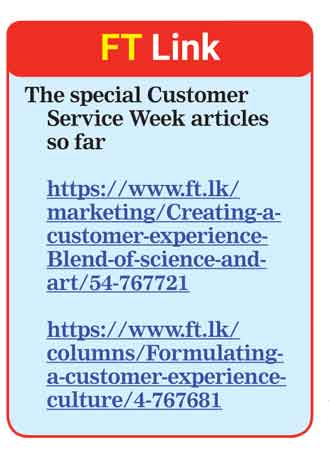Thursday Jan 08, 2026
Thursday Jan 08, 2026
Thursday, 10 October 2024 00:10 - - {{hitsCtrl.values.hits}}

 The customer is the primary focus of any business. Even with the best intentions, companies sometimes fail to meet customer expectations, leading to dissatisfaction. This often occurs owing to the following issues:
The customer is the primary focus of any business. Even with the best intentions, companies sometimes fail to meet customer expectations, leading to dissatisfaction. This often occurs owing to the following issues:
Responsiveness
When a problem arises, customers usually contact the company right away, expecting an immediate response. Responsiveness plays a crucial role in shaping the customer experience. Customers expect their issues to be resolved on the first contact or at least within the shortest possible time. Therefore, decision-making power should be as close to the customer as possible.
However, there are instances when the service provider genuinely needs more time to resolve the issue owing to internal or external factors. In such instances, keeping the customer informed about the progress on the process can ease their concerns. Ignoring calls or failing to respond to emails only intensifies the customer’s frustration. As the saying goes, “Customers don’t mind waiting as long as they are kept aware; what they dislike is being left in the air.”
Clarity
 Customers need clear and straightforward communication. This starts with active listening, where the intent is to understand the customer rather than simply respond. Proper listening allows you to comprehend the customer’s exact needs.
Customers need clear and straightforward communication. This starts with active listening, where the intent is to understand the customer rather than simply respond. Proper listening allows you to comprehend the customer’s exact needs.
Confusing or ambiguous instructions can frustrate customers. For example: “We can manage without the original document, but it’s better to have it. Anyway, bring the original.” This kind of messaging leaves the customer unsure of what to do. Similarly, using too many negative words to create a positive impression can be counterproductive. For example: “It’s not common to face this issue, which, unfortunately, you did here. Not that we won’t take action to prevent your dissatisfaction.” Such statements only confuse an already frustrated customer. Be simple and concise in your communication.
Use terms and diagrams that customers are familiar with and that are easy to follow. Shorter, positively framed messages inspire action. For example: “Whatever you purchase inside the supermarket, you are free to consume in the lobby area beyond the cashier point.” This is a clear and appealing way to communicate that food shouldn’t be consumed before payment.
Accuracy
Accuracy in everything you do should be a habit, not just an action. Always strive to meet the customer’s exact requirements. Customers value their time, money, and effort, and mistakes cause significant inconvenience. Adopting a practice like ‘Check twice, do it right once’ is beneficial for everyone. ‘Paying attention to detail’ is crucial as well.
It starts with getting the customer’s name right, correctly entering information into the system, and pronouncing names properly. A person’s name is the most pleasant thing they like to hear repeatedly. Accuracy in the address, content, and context is essential for delivering a great customer experience.
For example, sending an email that mentions an attachment, but the attachment is missing, or sending a letter that says supporting documents are enclosed, but some are misplaced, creates frustration. Over-relying on spell check can also cause problems when the wrong word is selected. Mistakes like using ‘attack’ instead of ‘attract’, ‘massage’ instead of ‘message’, ‘sing’ instead ‘sign’, ‘apart’ instead ‘a part’ or ‘grate’ instead ‘great’ distort the meaning. Misplacing a comma in a sentence can have serious consequences. For instance, “Hang him not, release him” can be disastrously altered to “Hang him, not release him” if written incorrectly. Accuracy should never be taken for granted.
Relevance
Understanding the customer’s demographics is key. Once you have this information, you can offer solutions that are relevant and meet the customer’s specific expectations. Anticipating the customer’s needs and offering tailored solutions are essential for any business with foresight. Digitisation should not only lead to standardisation and automation but personalisation. Using a Customer Relationship Management (CRM) system constructively can help facilitate customer value creation.
For example, a bank notices that a customer’s savings account has a substantial balance that hasn’t been touched for a while. Using the CRM, the bank could propose moving the money to a fixed deposit, creating value for the customer. Focusing on creating more value for existing customers is often more beneficial than merely attracting new ones merely to meet targets.
Asking customers for the same information repeatedly, despite already having it in the system, wastes their time and effort. Insisting on additional evidence for something already established can also be frustrating. Of course, requesting information is acceptable when it’s necessary for strict compliance requirements. Most often these requests are being done for the sake of doing without serving any real purpose and adding no value.
We often talk about ‘digital convenience’, but is it truly centred on the customer? Sending a payment reminder is useful but imagine a scenario where the customer has already made the payment and still receives a final reminder. A message that at the end says, “If you’ve already paid, please ignore this message,” creates unnecessary discomfort. The system should be capable of identifying completed payments to avoid sending irrelevant messages.
In conclusion, while these common mistakes may seem minor, they can significantly harm the customer experience, sometimes even leading to broken relationships. These issues can be resolved by adopting an empathetic approach toward the customer. The key principle should be: “The customer’s best interest is always in my heart, and I am passionate about resolving their issues.”
(The writer is a sought-after ‘Customer Experience’ specialist in Sri Lanka. Over the last 28 years he has conducted nearly 3,300 inspirational and educational programs for over 800 organisations’ in 11 countries. His work can be seen at www.dhammikakalapuge.com.)